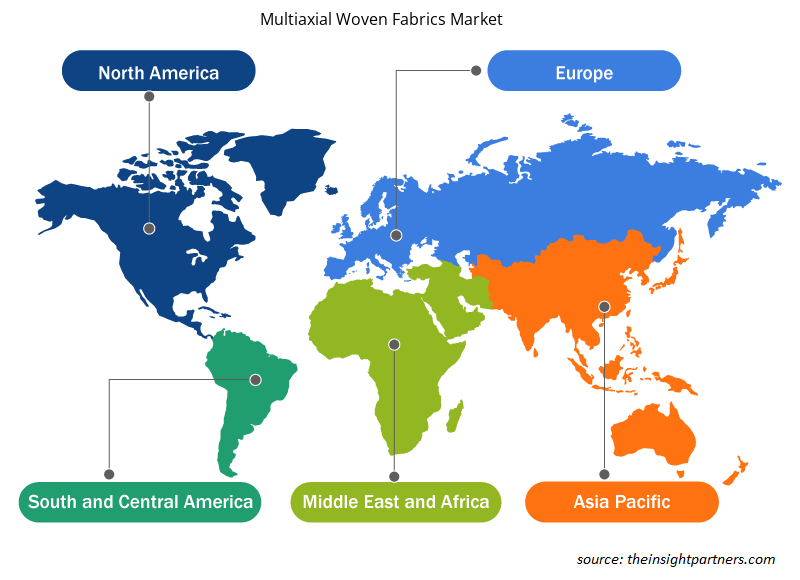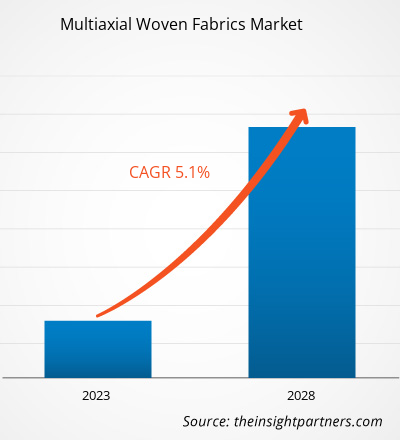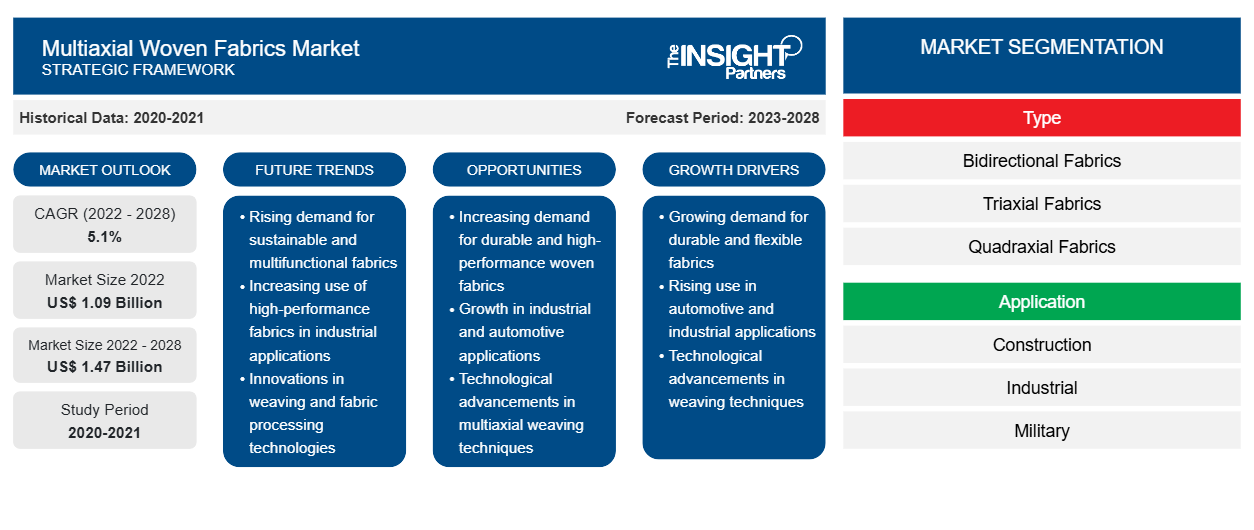[Informe de investigación] Se espera que el tamaño del mercado de tejidos multiaxiales crezca de US$ 1.089,17 millones en 2022 a US$ 1.469,01 millones en 2028; se estima que registrará una CAGR del 5,1% de 2022 a 2028.
Los tejidos multiaxiales se fabrican utilizando diferentes tipos de fibras, como fibra de vidrio , fibra de carbono, fibra de aramida y fibra natural, y una combinación de fibras. Los tejidos bidireccionales, los tejidos triaxiales y los tejidos cuadriaxiales son algunos tipos de tejidos multiaxiales. Los tejidos multiaxiales se aplican en diferentes industrias de uso final, como la construcción, los bienes de consumo y el ejército.
Europa dominó la participación de mercado global de tejidos multiaxiales en 2022. Según el país, el mercado europeo de tejidos multiaxiales está segmentado en Alemania, Francia, Italia, Reino Unido, Rusia y el resto de Europa. El aumento del uso de materiales compuestos en diversas industrias de uso final y el fuerte crecimiento de las industrias automotriz, marina, aeroespacial y de la construcción en Europa impulsan el crecimiento del mercado regional de tejidos multiaxiales. En el Reino Unido, la energía eólica es una de las mayores fuentes de generación de electricidad. El gobierno del país ha incluido la energía eólica en el Plan de diez puntos para una revolución industrial verde y en el Libro Blanco de la energía. La industria de la energía eólica está desempeñando un papel importante en la transición energética de Alemania. Según Germany Trade & Invest, Alemania es el principal mercado de energía eólica de Europa, con más de 63 GW de capacidad total. El creciente sector de la energía eólica en Europa impulsa la demanda de tejidos multiaxiales.
Personalice este informe según sus necesidades
Obtendrá personalización en cualquier informe, sin cargo, incluidas partes de este informe o análisis a nivel de país, paquete de datos de Excel, así como también grandes ofertas y descuentos para empresas emergentes y universidades.
-
Obtenga las principales tendencias clave del mercado de este informe.Esta muestra GRATUITA incluirá análisis de datos, desde tendencias del mercado hasta estimaciones y pronósticos.
Impacto de la pandemia de COVID-19 en el mercado de tejidos multiaxiales
Antes de la pandemia de COVID-19, el mercado de tejidos multiaxiales estaba impulsado principalmente por industrias como la automotriz, la construcción, la aeroespacial y la defensa, la energía eólica y la marina. En 2020, varias industrias tuvieron que ralentizar sus operaciones debido a las interrupciones en las cadenas de suministro provocadas por el cierre de las fronteras nacionales e internacionales. La pandemia obstaculizó los procesos de fabricación debido a las restricciones impuestas por las autoridades gubernamentales en varios países. Los tejidos multiaxiales tienen importantes aplicaciones en las industrias aeroespacial y de defensa y automotriz, donde se utilizan para controlar el peso corporal de los vehículos y la gestión del combustible. También se utiliza ampliamente en el sector de la construcción. Por tanto, con la reducción de la actividad en estos sectores, la demanda de tejidos multiaxiales también disminuyó. La pandemia también provocó fluctuaciones en los precios de las materias primas. Todos estos factores llevaron a una disminución de la demanda de tejidos multiaxiales. Sin embargo, en 2021, las economías comenzaron a reactivarse a medida que varias industrias reanudaron sus actividades comerciales. Como resultado, varias industrias, incluidas la aeroespacial y la defensa, la automotriz y la construcción, mostraron signos de recuperación en sus operaciones. Varias industrias también están superando las consecuencias de las interrupciones en sus cadenas de suministro de materias primas. Con una recuperación tan prometedora, se espera que el sector industrial mundial proporcione el impulso para el crecimiento del mercado de tejidos multiaxiales en los próximos años.
Perspectivas del mercado
El fuerte crecimiento de la industria de los materiales compuestos impulsa el crecimiento del mercado de los tejidos multiaxiales
Los tejidos multiaxiales se utilizan para reforzar materiales compuestos. La creciente demanda de materiales de alto rendimiento con propiedades como una alta relación resistencia-peso, buena resistencia a la tracción, conductividad eléctrica y otras impulsa el crecimiento de la industria de los compuestos. Además, existe una creciente demanda de compuestos de diversas industrias de uso final, como la automotriz, los artículos deportivos, la marina, la construcción y la energía eólica. En la industria automotriz, los fabricantes prefieren materiales livianos para fabricar automóviles al tiempo que garantizan la seguridad y el rendimiento. Los materiales livianos tienen un excelente potencial para aumentar la eficiencia del combustible. Los compuestos pueden reducir el peso de los componentes automotrices, lo que aumenta su uso en el sector automotriz. También existe una gran demanda de compuestos para su uso como materiales de construcción en equipos deportivos de alto rendimiento debido a su ligereza, alta resistencia, libertad de diseño y características de fácil procesamiento y conformado. Los compuestos se utilizan en equipos deportivos como esquís, bates de béisbol, palos de golf, raquetas de tenis y cuadros de bicicletas. Los compuestos se utilizan mucho en la industria marina porque son duraderos y livianos. Los compuestos pesan menos que los materiales de construcción marina tradicionales, lo que los hace adecuados para su uso en la construcción de embarcaciones. Además, los materiales compuestos se utilizan como materiales de refuerzo en diversas aplicaciones de energía eólica. El creciente uso de materiales compuestos en diferentes industrias de uso final impulsa el crecimiento de la industria de los materiales compuestos. Por lo tanto, el fuerte crecimiento de la industria de los materiales compuestos está impulsando el crecimiento del mercado de tejidos multiaxiales.
Tipo de información
Según el tipo, el mercado mundial de tejidos multiaxiales se segmenta en tejidos bidireccionales, tejidos triaxiales, tejidos cuadriaxiales y otros. El segmento de tejidos cuadriaxiales tuvo la mayor participación de mercado en 2022. Un tejido cuadriaxial consta de cuatro capas de orientación de fibra en los ángulos 0°, +45°, 90° y -45°. Este tejido proporciona resistencia en todas las direcciones. Se utilizan ampliamente para el laminado manual, la inyección o infusión y el moldeo por transferencia de resina. Este tejido se puede producir con la máxima densidad aérea en comparación con cualquier otro estilo de tejido.
3D Weaving SaRL, Sigmatex (UK) Ltd, Textum OPCO LLC, Cristex Composite Materials Ltd, Biteam AB, Albany International Corp, Tantra Composite Technologies Pvt Ltd, Parabeam BV, Halarit Composites GmbH y SGL Carbon SE son algunos de los actores que operan en el mercado global de tejidos multiaxiales. Los actores del mercado se centran en proporcionar productos de alta calidad para satisfacer la demanda de los clientes. También están adoptando estrategias como inversiones en investigación y desarrollo, lanzamientos de nuevos productos, colaboraciones y fusiones y adquisiciones.
Perspectivas regionales del mercado de tejidos multiaxiales
Los analistas de Insight Partners explicaron en detalle las tendencias y los factores regionales que influyen en el mercado de tejidos multiaxiales durante el período de pronóstico. Esta sección también analiza los segmentos y la geografía del mercado de tejidos multiaxiales en América del Norte, Europa, Asia Pacífico, Oriente Medio y África, y América del Sur y Central.

- Obtenga datos regionales específicos para el mercado de tejidos multiaxiales
Alcance del informe de mercado de tejidos multiaxiales
| Atributo del informe | Detalles |
|---|---|
| Tamaño del mercado en 2022 | 1.090 millones de dólares estadounidenses |
| Tamaño del mercado en 2028 | 1.470 millones de dólares estadounidenses |
| CAGR global (2022-2028) | 5,1% |
| Datos históricos | 2020-2021 |
| Período de pronóstico | 2023-2028 |
| Segmentos cubiertos |
Por tipo
|
| Regiones y países cubiertos |
América del norte
|
| Líderes del mercado y perfiles de empresas clave |
|
Densidad de actores del mercado de tejidos multiaxiales: comprensión de su impacto en la dinámica empresarial
El mercado de tejidos multiaxiales está creciendo rápidamente, impulsado por la creciente demanda de los usuarios finales debido a factores como la evolución de las preferencias de los consumidores, los avances tecnológicos y una mayor conciencia de los beneficios del producto. A medida que aumenta la demanda, las empresas amplían sus ofertas, innovan para satisfacer las necesidades de los consumidores y aprovechan las tendencias emergentes, lo que impulsa aún más el crecimiento del mercado.
La densidad de actores del mercado se refiere a la distribución de las empresas o firmas que operan dentro de un mercado o industria en particular. Indica cuántos competidores (actores del mercado) están presentes en un espacio de mercado determinado en relación con su tamaño o valor total de mercado.
Las principales empresas que operan en el mercado de tejidos multiaxiales son:
- Tejido 3D SaRL
- Sigmatex (Reino Unido) Ltd
- Texto OPCO LLC
- Materiales compuestos Cristex Ltd.
- Biteam AB
Descargo de responsabilidad : Las empresas enumeradas anteriormente no están clasificadas en ningún orden particular.

- Obtenga una descripción general de los principales actores clave del mercado de tejidos multiaxiales
Informe Destacado
- Tendencias progresivas de la industria en el mercado de tejidos multiaxiales para ayudar a los actores a desarrollar estrategias efectivas a largo plazo
- Estrategias de crecimiento empresarial adoptadas por los mercados desarrollados y en desarrollo
- Análisis cuantitativo del mercado de tejidos multiaxiales de 2020 a 2028
- Estimación de la demanda mundial de tejidos multiaxiales
- Análisis de las cinco fuerzas de Porter para ilustrar la eficacia de los compradores y proveedores que operan en la industria
- Avances recientes para comprender el escenario competitivo del mercado
- Tendencias y perspectivas del mercado, así como factores que impulsan y restringen el crecimiento del mercado de tejidos multiaxiales
- Asistencia en el proceso de toma de decisiones destacando las estrategias de mercado que sustentan el interés comercial y conducen al crecimiento del mercado.
- El tamaño del mercado de tejidos multiaxiales en varios nodos
- Descripción detallada y segmentación del mercado, así como la dinámica de la industria de tejidos multiaxiales.
- Tamaño del mercado de tejidos multiaxiales en varias regiones con prometedoras oportunidades de crecimiento
- Análisis histórico (2 años), año base, pronóstico (7 años) con CAGR
- Análisis PEST y FODA
- Tamaño del mercado, valor/volumen: global, regional y nacional
- Industria y panorama competitivo
- Conjunto de datos de Excel
Informes recientes
Testimonios
Razón para comprar
- Toma de decisiones informada
- Comprensión de la dinámica del mercado
- Análisis competitivo
- Información sobre clientes
- Pronósticos del mercado
- Mitigación de riesgos
- Planificación estratégica
- Justificación de la inversión
- Identificación de mercados emergentes
- Mejora de las estrategias de marketing
- Impulso de la eficiencia operativa
- Alineación con las tendencias regulatorias























 Obtenga una muestra gratuita para - Mercado de tejidos multiaxiales
Obtenga una muestra gratuita para - Mercado de tejidos multiaxiales